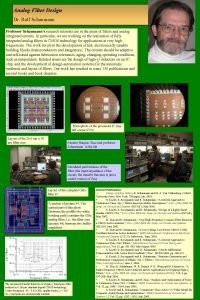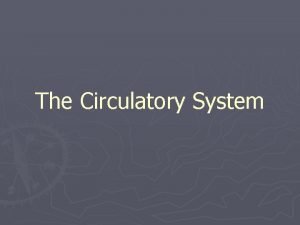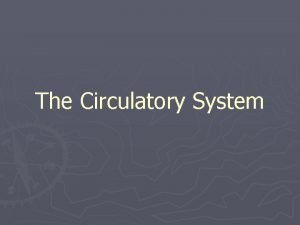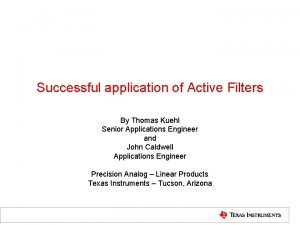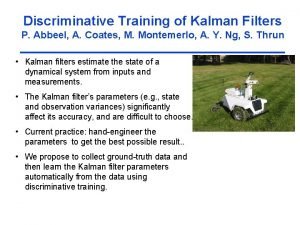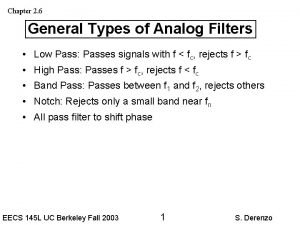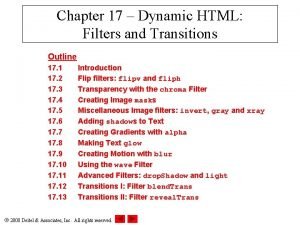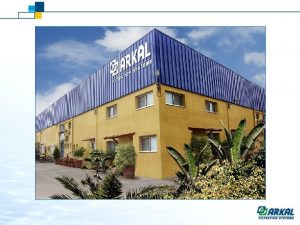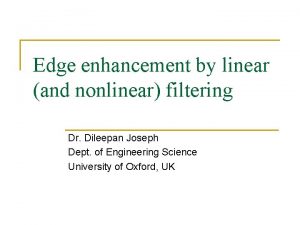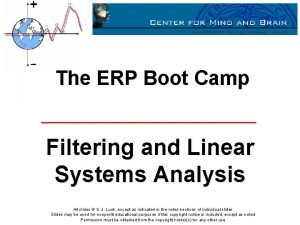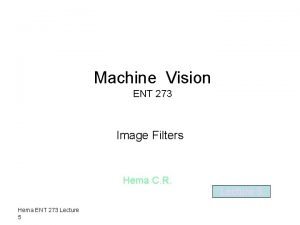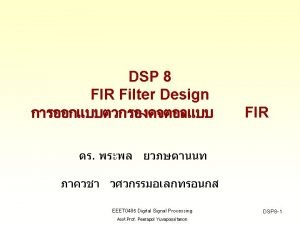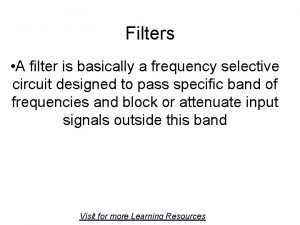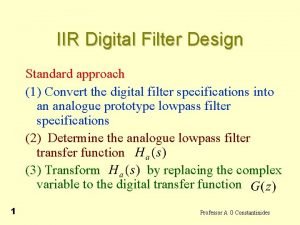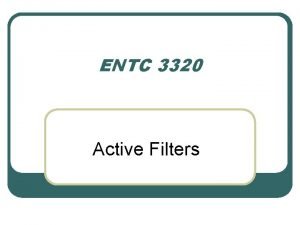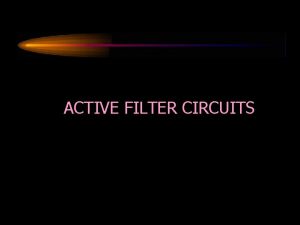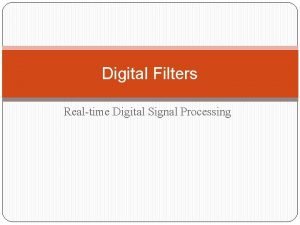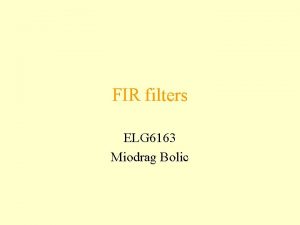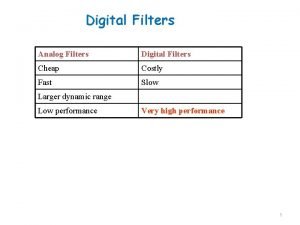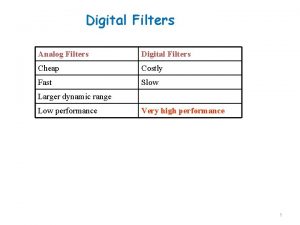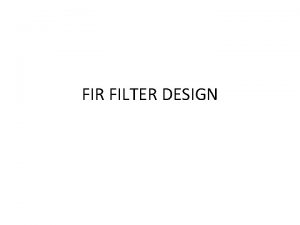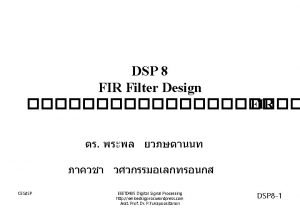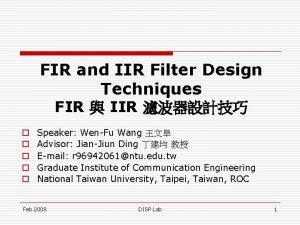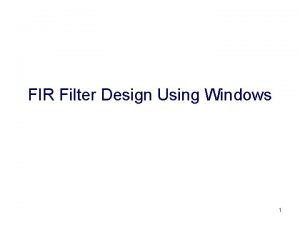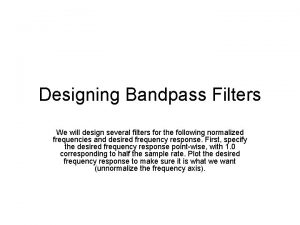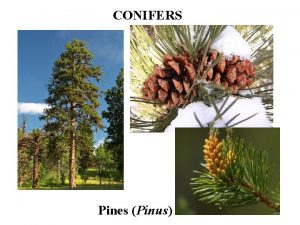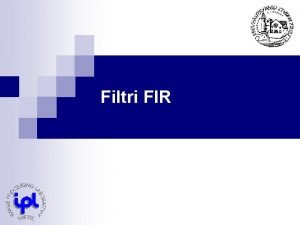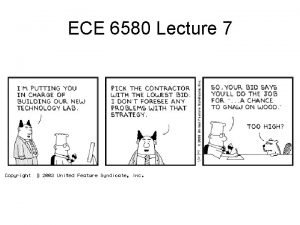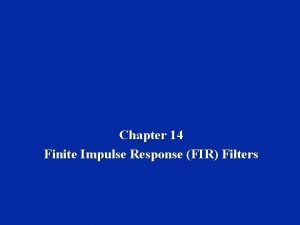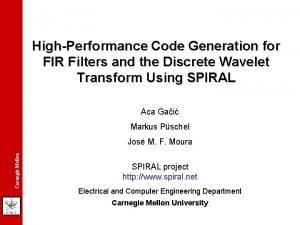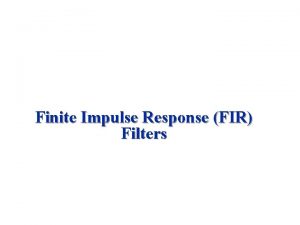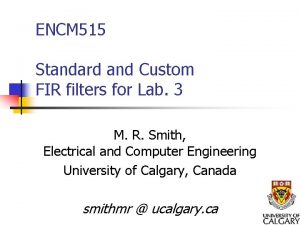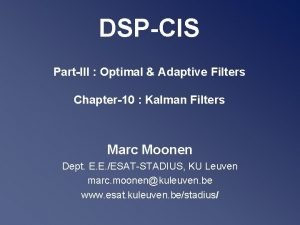LINEARPHASE FIR FILTERS DESIGN Prof Siripong Potisuk FIR




![Generalized Linear-phase Filters This is the necessary condition for h[n] to have linear phase. Generalized Linear-phase Filters This is the necessary condition for h[n] to have linear phase.](https://slidetodoc.com/presentation_image_h/7e46340b20e299f17d7e1eb363c0d04c/image-5.jpg)
![Types of Linear-phase FIR filters Filter h[n] Filter Phase End-point type symmetry order offset Types of Linear-phase FIR filters Filter h[n] Filter Phase End-point type symmetry order offset](https://slidetodoc.com/presentation_image_h/7e46340b20e299f17d7e1eb363c0d04c/image-6.jpg)
























- Slides: 30

LINEAR-PHASE FIR FILTERS DESIGN Prof. Siripong Potisuk

FIR Filter Characteristics l Completely specified by input-output relation: l bk = filter coefficients and M +1 = filter length All poles are at the origin always stable Impulse response has only a finite number of terms finite length l l

Group Delay l Negative of the slope of the phase response of a linear system, i. e. , filters l The amount by which the spectral component at frequency f gets delayed as it is processed by the filter A digital linear-phase filter has a constant group delay except possibly at frequencies at which the magnitude response is zero l

Generalized Linear-phase Filters where Ar( ) = Amplitude Response of H( ), = phase offset, and = group delay
![Generalized Linearphase Filters This is the necessary condition for hn to have linear phase Generalized Linear-phase Filters This is the necessary condition for h[n] to have linear phase.](https://slidetodoc.com/presentation_image_h/7e46340b20e299f17d7e1eb363c0d04c/image-5.jpg)
Generalized Linear-phase Filters This is the necessary condition for h[n] to have linear phase. Two possible cases: (even symmetry) (odd symmetry)
![Types of Linearphase FIR filters Filter hn Filter Phase Endpoint type symmetry order offset Types of Linear-phase FIR filters Filter h[n] Filter Phase End-point type symmetry order offset](https://slidetodoc.com/presentation_image_h/7e46340b20e299f17d7e1eb363c0d04c/image-6.jpg)
Types of Linear-phase FIR filters Filter h[n] Filter Phase End-point type symmetry order offset zeros Candidate filters 1 Even 0 None All 2 Even Odd 0 z = 1 LP, BP 3 Odd Even /2 z = 1 BP 4 Odd /2 z=1 HP, BP

Impulse Responses of Four Types of FIR Linear-phase Filters

Linear-phase Zeros l l l l Symmetry condition imposes constraints on the zeros of a linear-phase FIR filter Transfer function satisfies: Type 1: no restriction on end-point zeros Type 2: an end-point zero at z = -1 Type 3: end-point zeros at z = 1 Type 4: an end-point zero at z = 1 All types: complex zeros in groups of four (r 1)

Pole-zero Plot of a Sixth-order, Type-1 Linear-phase FIR Filter

Example Construct a type 1 linear-phase filter of order 2 with Coefficients satisfying |bk| =1, k. Also, find the transfer function and its zeros.

Example Construct a type 2 linear-phase filter of order 1 with Coefficients satisfying |bk| =1, k. Also, find the transfer function and its zeros.

Example Construct a type 3 linear-phase filter of order 2 with Coefficients satisfying |bk| =1, k. Also, find the transfer function and its zeros.

Example Construct a type 4 linear-phase filter of order 1 with Coefficients satisfying |bk| =1, k. Also, find the transfer function and its zeros.

The Windowing Method l l l Start with the desired or ideal frequency response with appropriate delay Compute IDTFT to obtain the desired impulse response according the filter type & order Truncate the resulting impulse response using one of the finite-length windowing functions, i. e. , Rectangular, Bartlett, Hamming, Hanning, and Blackman

Ideal Lowpass Characteristics

Impulse Responses of Ideal Linear-phase type-1 FIR filters of Order M = 2 Filter type Lowpass Highpass Bandstop h[n], 0 k M, k h[ ]

Example Construct a type 1 linear-phase filter of order 6 with coefficients satisfying the highpass response characteristics and cutoff frequency of 2000 Hz assuming a sampling frequency of 8000 Hz. Also, find the transfer function and generate the polezero plot. Repeat for order 40.

Windowing (Truncation) Effect 1. Passband & Stopband ripples caused by sidelobes 2. Transition bandwidth dependent on mainlobe width

Commonly-used Windowing Functions


Effects of Window Shape & Size l l For a fixed size window, window shape affects both the mainlobe width and sidelobe height Window size affects the mainlobe width only

Green = Hamming Red = Hanning Teal = Blackman Blue = Rectangular

Meeting Design Specifications • Appropriate window selected based on frequencydomain specifications • Estimate the filter order, M, to control the width of the normalized transition band of the filter.

MATLAB Implementation l Function B = firwd(N, Ftype, WL, WH, Wtype) l MATLAB user-defined function for FIR filter design using the windowing method (text, pp. 288 -290) l Input Arguments: N = number of filter taps (must be an odd number) = M+1 where M is a filter order (even number for Type 1) Ftype = filter type ( 1 – lowpass, 2 – highpass, 3 – Bandpass, 4 – bandstop ) WL = lower cut-off frequency in rad (set to zero for highpass) WH = upper cutoff frequency in rad (set to zero for lowpass) Wtype = window type ( 1 – rectangular, 2 – triangular, 3 – Hanning, 4 – Hamming, 5 – Blackman )

Design Characteristics of Windows Passband Ripple Stopband Attenuation Window Type Filter Order (M) p Ap (d. B) s As (d. B) Rectangular 0. 9/ F 0. 0819 0. 7416 0. 0819 21 Hanning 3. 1/ F 0. 0063 0. 0546 0. 0063 44 Hamming 3. 3/ F 0. 0022 0. 0194 0. 0022 53 Blackman 5. 5/ F 0. 00017 74

Example 7. 11 Design a type 1 linear-phase filter with coefficients satisfying bandstop response characteristics with the following specifications: Lower cutoff frequency of 1250 Hz Lower transition width of 1500 Hz Upper cutoff frequency of 2850 Hz Upper transition width of 1300 Hz Stopband attenuation of 60 d. B Passband ripple of 0. 02 d. B Sampling frequency of 8000 Hz.


Kaiser Window l Near-optimal window defined as l = M/2, and I 0( ) represents the zeroth-order modified Bessel function of the 1 st kind Two parameters: M +1 = filter length and = shape parameter l

Kaiser Window Characteristics

Design Method where P is the passband cutoff frequency T is the stopband cutoff frequency is the passband ripple and stopband attenuation
 Rolf schaumann
Rolf schaumann Etching cleaning process
Etching cleaning process Filters in weka
Filters in weka Lymph nodes: “filters of the blood”
Lymph nodes: “filters of the blood” Lymph nodes: “filters of the blood”
Lymph nodes: “filters of the blood” Application of active filters
Application of active filters Ironport outbreak filters
Ironport outbreak filters Discriminative training of kalman filters
Discriminative training of kalman filters Columbus industries filters distributor
Columbus industries filters distributor Types of analog filters
Types of analog filters Filters and transitions in dhtml
Filters and transitions in dhtml Disc filters galaxy 4 spin klin series
Disc filters galaxy 4 spin klin series Difference between linear and nonlinear spatial filters
Difference between linear and nonlinear spatial filters Permatron cottonwood screens
Permatron cottonwood screens Erp bootcamp
Erp bootcamp Ent
Ent Hpf lpf bpf
Hpf lpf bpf Write two advantages of large volume parenterals.
Write two advantages of large volume parenterals. Our personal filters assumptions
Our personal filters assumptions Practical frequency selective filters basically
Practical frequency selective filters basically Body language
Body language Joint legacy viewer
Joint legacy viewer Spectral transformation of iir filters
Spectral transformation of iir filters Advantages of active filters
Advantages of active filters Active vs passive low pass filter
Active vs passive low pass filter Bacterial filters ppt
Bacterial filters ppt Perceptual filters
Perceptual filters Emfab filters
Emfab filters Impulse invariant method formula
Impulse invariant method formula Signal processing filter
Signal processing filter Authentication filters in mvc 5
Authentication filters in mvc 5
